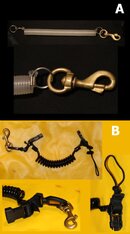Hello,
I have been using the standard Cetacea coil lanyard (with plastic clips at both ends as well as with a lanyard loop at one end) for several years to attach my camera to my BC.
I just significantly upgraded my gear (EOS 10D/Ikelite housing to an EOS 7D/Nauticam housing), and I got to thinking about my old tether system. Also, I find the the Cetacea system is a bit short, making maneuvering the new camera a little more difficult. I was in the keys and picked up a Trident speargun retriever coil, which I was told was as secure if not more so than the Cetacea coil.
The Trident is much less restrictive on the camera, but given how much I just spent on camera gear, I want to make sure that whatever I use will not give way if I inadvertently lose control and the system gets yanked. Not so much of an issue on a shallow reef in the Keys, but if I am diving in the northeast with a deeper bottom in poor visibility, a single failure point might be the end of my new gear...!
So here are the two systems, with closeup photos. What do you think? The Trident (A) or the Cetacea (B). Which are the most likely failure points? The steel clip on the Trident? The string on the lanyard? Plastic clips? Is there a better system that I am missing?

Thanks!
Mike
I have been using the standard Cetacea coil lanyard (with plastic clips at both ends as well as with a lanyard loop at one end) for several years to attach my camera to my BC.
I just significantly upgraded my gear (EOS 10D/Ikelite housing to an EOS 7D/Nauticam housing), and I got to thinking about my old tether system. Also, I find the the Cetacea system is a bit short, making maneuvering the new camera a little more difficult. I was in the keys and picked up a Trident speargun retriever coil, which I was told was as secure if not more so than the Cetacea coil.
The Trident is much less restrictive on the camera, but given how much I just spent on camera gear, I want to make sure that whatever I use will not give way if I inadvertently lose control and the system gets yanked. Not so much of an issue on a shallow reef in the Keys, but if I am diving in the northeast with a deeper bottom in poor visibility, a single failure point might be the end of my new gear...!
So here are the two systems, with closeup photos. What do you think? The Trident (A) or the Cetacea (B). Which are the most likely failure points? The steel clip on the Trident? The string on the lanyard? Plastic clips? Is there a better system that I am missing?
Thanks!
Mike





